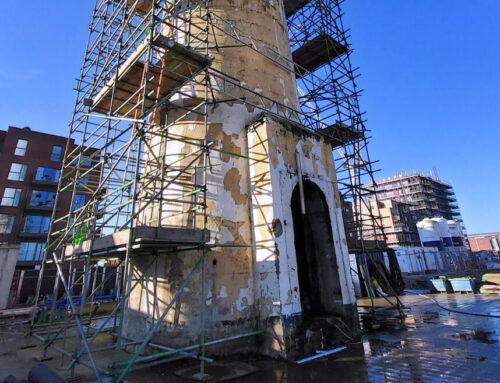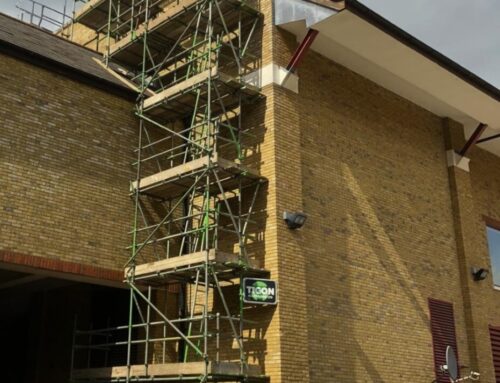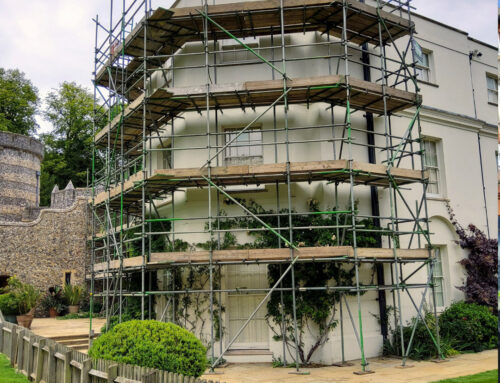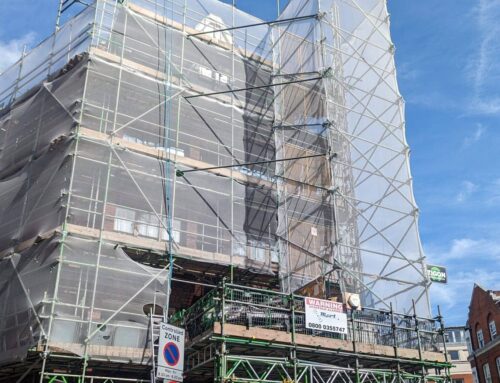Why are Ancient Scaffolding Techniques so Important?
In the modern construction industry, scaffolding has become an indispensable tool, playing a vital role in ensuring the safety and efficiency of workers as they undertake projects. But let’s take a moment to step back in time and ponder a fascinating question: How did ancient builders create awe-inspiring structures like Egypt’s pyramids and Europe’s cathedrals without today’s advanced scaffolding technology?
Our journey through history will talk about the fascinating world of ancient scaffolding techniques– a world where creativity and resourcefulness were the cornerstones of progress. These techniques not only facilitated the creation of architectural marvels but also left an indelible mark on the history of construction, showcasing the extraordinary capabilities of human ingenuity. Tigon Scaffolding owes its position today to this rich history, from ancient civilizations to modern times, scaffolding has been instrumental in facilitating construction projects of all scales. It’s through the collective efforts of countless builders and innovators over the centuries that we now have access to safer, more efficient, and more versatile scaffolding solutions. So let’s delve into various ancient scaffolding techniques that have paved the way for scaffolding to reach its current state of excellence.
Bamboo Scaffolding in Ancient China
One of the earliest recorded instances of scaffolding harkens back to ancient China, a civilization renowned for its ingenious inventions and resourcefulness. Bamboo, which was both readily available and incredibly versatile, took centre stage in the realm of scaffolding. Historical records reveal that the Chinese employed bamboo scaffolding as early as the 4th century BC, a period marked by the monumental construction of the Great Wall of China.
The choice of bamboo as the scaffolding material of preference was not arbitrary; it was rooted in its exceptional qualities. Bamboo scaffolds emerged as a remarkable solution due to their unique combination of characteristics. They were exceptionally lightweight, ensuring ease of transport and assembly. Moreover, their inherent sturdiness and structural integrity provided the essential support needed to reach remarkable heights during construction projects. These ancient bamboo scaffolds bore witness to the boundless ingenuity of the Chinese builders, serving as a testament to their ability to adapt and innovate in their pursuit of architectural excellence.
The Ingenious Use of Earthen Ramps in Ancient Egypt
In ancient Egypt, a civilization renowned for its awe-inspiring pyramids that captivated the world, builders devised an ingenious method using earthen ramps. These ramps, crafted from locally available materials like mudbrick and sand, served a crucial purpose: they provided a practical means for workers to transport massive stone blocks to various levels of the pyramid, a task that would otherwise have been nearly insurmountable. The brilliance of the ancient Egyptian builders lay not only in their ability to design and construct the iconic pyramids but also in their deep understanding of physics and engineering principles. These earthen ramps, while seemingly straightforward, represented a sophisticated approach to problem-solving, showcasing the resourcefulness of a civilization that continues to inspire wonder and admiration today.
Wooden Scaffolds in Medieval Europe
Medieval Europe witnessed the construction of breathtaking cathedrals, and wooden scaffolding played a pivotal role in these projects. Builders used wooden poles, planks, and supports to create temporary structures around the cathedral’s exterior. These wooden scaffolds provided access for craftsmen to work on intricate details, stained glass windows, and towering spires. During this era, the utilization of wooden scaffolds highlighted the exceptional craftsmanship and thorough preparation that characterized the construction of these magnificent structures. These scaffolds transcended mere functionality; they stood as a tribute to the unwavering commitment of the skilled artisans and builders who dedicated their efforts to these colossal edifices. They allowed for the creation of intricate masterpieces that have withstood the test of time and continue to evoke wonder and admiration in the present day.
Ancient Greek and Roman Innovation
In the ancient world of Greece and Rome, where monumental structures like the Parthenon and the Colosseum were created, innovative scaffolding techniques were a necessity. Greek builders utilized wooden platforms and scaffolds to access various sections of their temples. In contrast, Roman engineers displayed their remarkable skills by developing advanced hoisting systems, cranes, and scaffolding to erect iconic arches, aqueducts, and arenas.
Within ancient Rome, innovation knew no bounds, especially in scaffolding. Romans frequently utilized wooden cages and hinged platforms, cleverly referred to as “caged ladders,” to streamline work on the exteriors of their grand structures. These ingenious contrivances served a dual purpose, offering both safety and adaptability. Craftsmen could effortlessly adjust these scaffolding cages to their needs, providing a secure and flexible platform for a wide range of construction tasks. These ancient Greek and Roman innovations in scaffolding underscored their unparalleled mastery of engineering and construction. The use of wooden platforms and advanced hoisting systems demonstrated a commitment to precision and efficiency that was ahead of their time. These pioneering techniques not only facilitated the construction of architectural marvels but also served as a testament to the enduring legacy of these ancient civilizations in shaping the course of human history and architectural excellence.
Maya’s Tree Scaffolding: A Central American Marvel
In the dense rainforests of Central America, the ancient Maya demonstrated remarkable resourcefulness in their construction methods. They often utilized tall trees as natural scaffolding when building their magnificent temples. This innovative approach involved crafting wooden platforms around these towering trees, enabling them to access the higher sections of the temples with ease. The Maya’s choice of using the surrounding trees as scaffolding was not arbitrary. They carefully selected trees, including the majestic ceiba tree, which held special cultural significance for them. To transform these trees into scaffolds, skilled craftsmen ingeniously attached wooden platforms to the sturdy trunks. These elevated workspaces not only facilitated the construction process but also provided surfaces for artisans to adorn the temple facades with intricate carvings and designs.
The Legacy of Ancient Construction Methods
While these ancient scaffolding techniques may seem rudimentary by today’s standards, they were groundbreaking innovations in their time. They allowed ancient civilizations to achieve architectural feats that continue to inspire wonder and admiration to this day. The legacy of these techniques can still be seen in the enduring structures that stand as a testament to human ingenuity and craftsmanship. In many ways, the ingenuity of these early scaffolding methods paved the way for the sophisticated systems we employ today. Their resourcefulness and determination to reach new heights have left an indelible mark on the world of construction and engineering. As we marvel at the architectural wonders of the past, we are reminded that the spirit of innovation and the pursuit of excellence have been driving forces in shaping the course of human history—a legacy we continue to honour and build upon in the modern era.
Challenges and Triumphs of the Past
It’s also essential to recognize the challenges that builders faced, without modern safety standards and equipment, working at great heights was perilous. Accidents and injuries were frequent, and yet, these remarkable structures were completed through sheer determination and skill. As we reflect on the challenges endured by those early builders, we gain a profound appreciation for their unwavering commitment to their craft.
Preserving and Studying Past Scaffolding Techniques
Today, archaeologists study the remnants of historic scaffolding systems to gain insights into the construction methods and tools of the past. These studies help us appreciate the craftsmanship of our ancestors and provide valuable lessons for modern construction practices, as well as recognize the importance of preserving and documenting these scaffolding techniques that got us where we are today. The knowledge gleaned from such endeavours not only enriches our understanding of the past but also informs our present and future construction endeavours. By preserving these remarkable traces of history, we ensure that the legacy of ancient scaffolding continues to inspire and educate generations to come, fostering a profound connection between our contemporary world and the architectural wonders of antiquity.
Conclusion: The Timeless Impact of Scaffolding
As we stand in awe of the architectural wonders of the past, it is both humbling and inspiring to recognize that they were brought to life through the ingenious and effective use of ancient scaffolding techniques. These time-honoured methods not only showcase the resourcefulness and determination of our ancestors but also serve as a testament to their unwavering commitment to leaving a lasting mark on the world. In an era where challenges were formidable, safety standards were rudimentary, and the concept of modern technology was yet to be realized, these visionary builders reached for the skies and achieved the extraordinary. As we look back on this rich history of scaffolding, we also cast our gaze forward to the future of this essential construction component. In the coming years, scaffolding will continue to evolve, incorporating cutting-edge materials, advanced safety features, and sustainable practices. The scaffolding of tomorrow will not only provide safe access to new heights but will also contribute to environmentally conscious construction processes. As we honour the legacy of ancient scaffolding, we embrace a future where innovation and tradition intersect, driving us to build a world that stands as a testament to both our heritage and our aspirations for generations to come.
Want to find out about how these developments have led to hazard identification in scaffolding, click here!
Read more!
Winter Scaffolding Safety Measures: Cold Weather Construction














